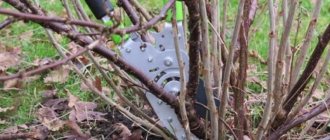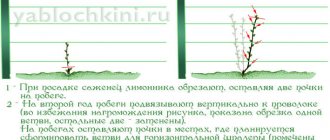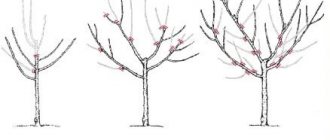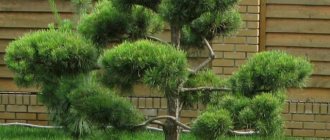Features of caring for forsythia in autumn
Despite the fact that forsythia is generally not a very demanding plant, it, like any other inhabitant of the garden, should be given attention and care to ensure that the bush does not grow too large and does not die in the first winter. Autumn procedures for preparing forsythia for the cold will not take much time, but will prevent a possible sad outcome for the plant
Preparing young shrubs for winter
Newly planted plants are quite vulnerable, even if they are hardy varieties. Like adult shrubs, they need thorough preparation for the winter season, without which the chances of survival are close to zero. For the first year of the plant's life, pruning is not required - this will significantly save your time. A mandatory procedure is mulching the root area with humus and covering the bushes.
You can cover young forsythia with branches of spruce branches or any covering material, the main thing is to cover the entire plant, and not just the roots. To do this, you will need to first bend the branches to the ground and pin them, and then begin covering. Remember: you cannot use airtight plastic film for these purposes, otherwise you risk depriving the plant of flowering due to the fact that the buds may dry out during the thaw. In extreme cases, forsythia under such material can rot.
Now you can be calm - under a layer of leaves and snow, forsythia is not afraid of any cold!
Timing and scheme for pruning forsythia in autumn
For this kind of ornamental shrubs such as forsythia, pruning is a mandatory procedure, since the plant tends to grow quite quickly and lose its beautiful shape. In addition, all diseased, frozen, dry and improperly growing branches need pruning. Autumn pruning is usually carried out to remove excess and damaged shoots. It must be carried out as early as possible so that the cutting areas have time to heal before the onset of cold weather. In addition, beware of overdoing it - the plant noticeably weakens after such procedures, and the fewer branches you remove, the easier it will be for it to overwinter.
Attention! Treat pruning with care and responsibility. If you get carried away with this activity and strive to rejuvenate the plant as often as possible, the bush will grow well and actively, but you will hardly see any inflorescences on it
Covering and mulching tree trunks
Forsythia bushes of any age and variety require additional insulation for the winter season. First, you should mulch the tree trunk area with humus - the layer should be at least 10 cm. Then you can begin to cover the bush. As in the case of young plants, the branches need to be bent tightly to the ground - it is better to do this before frost sets in, otherwise the branches will be stubborn - and then cover the entire bush with spruce branches, dry foliage or any artificial breathable material. Due to the fact that the plant will be protected in winter by a constructed shelter and a layer of snow, it will successfully withstand frost. In the spring, all covering material is removed, the branches rise back - and the bush is ready to bloom again!
Watering and fertilizing
Forsythia is extremely undemanding in relation to watering and does not tolerate waterlogging, so in the fall you can hardly worry about it. It will be enough to water the plant generously once a month; this procedure will take 10-12 liters of water for each bush. Water procedures need to be carried out a little more often if the forsythia is planted on sand - it is less permeable to moisture. As for fertilizers, in the fall it is worth applying 70 g per 1 square meter. meter of the mineral complex before mulching the trunk circles with humus or fallen leaves.
Haircut: timing and tools
Forsythia can be pruned in spring, summer and fall. The timing of autumn pruning is individual for each region, but remember that after the “haircut” the temperature must remain above zero for another couple of weeks so that the cuttings have time to tighten. In the northern regions of Russia, pruning is carried out in September, in the southern regions it is postponed to October.
To carry out the procedure, you will need a pruner, lopper or hacksaw - if you plan to trim old thick branches. Cuts on large branches (over 1.5 cm in diameter) should be treated with garden varnish. If the bush is young and pruning is being done for the first time, immediately decide on the future shape of the crown. Typically, spherical or cup-shaped are chosen for forsythia. Branches after pruning can be used for compost or raised beds, processed into mulch, diseased shoots are best burned.
Attention! Perform pruning only with sharp tools. A dull or improperly sharpened one will leave an uneven cut in which pathogenic bacteria or fungi can settle. For the same reason, avoid pruning in rainy weather.
Forsythia - care
How to care for forsythia.
Caring for forsythia is not much different from caring for any garden bush. If there is sufficient precipitation in the summer, the plant does not need watering, but if the summer turns out to be dry, then the forsythia will have to be watered at least once or twice a month at the rate of 10-12 liters for each bush. After watering, you need to loosen the soil and remove weeds, and you need to loosen it to the depth of a spade bayonet to ensure air access to the roots of the plant. After loosening, the tree trunk circle is mulched with compost or dry soil. Forsythia is fertilized three times per season: in early spring, a thick layer of rotted manure is spread around the tree trunk, but not close to the branches and trunk, then watered abundantly. Manure will serve as both mulch and organic nutrition for the plant. In April, complete mineral fertilizer is applied to the soil at the rate of 60-70 g per 1 m². After flowering, when the plant lays flower buds for the next year, forsythia is fed with all-purpose kemira at the rate of 100-120 g per 1 m².
Forsythia propagation.
Forsythia is most often propagated vegetatively. For example, green cuttings about 15 cm long, which are best cut in June. The lower leaves are removed, and the cuttings, having previously been treated with a root formation stimulator (root, epin or heteroauxin), are planted under a greenhouse in perlite or sand. You can also root lignified cuttings cut in October, and plant them directly in the soil in the garden, leaving two or three buds above the surface. You just need to cover the cuttings with dry leaves for the winter. In the spring, when you remove the cover, the established cuttings will begin to grow, and by autumn you will get beautiful seedlings. Forsythia is also propagated by layering: in summer or autumn, bend the lower young shoot to the ground, first pulling it at the base with wire and cutting the bark on the side that lies on the ground, secure it, sprinkle it with fertile soil, and the shoot will very soon form roots. In the spring, cut this branch from the bush, and the next year the young plant will bloom.
Forsythia also reproduces in a generative way, that is, by seeds, but this is a conversation for specialists.
Forsythia pruning.
Young forsythia bushes are subjected only to sanitary pruning - frozen, shriveled or broken shoots are removed. In adult plants, the frozen ends of the branches are cut off in the spring, but the main pruning is carried out in the summer, when flowering ends: faded branches are shortened by half, old and dried ones are cut off at a height of 4-6 cm from the soil level, and then side shoots will come from them. Pruning also helps to regulate the density, height and shape of the bush - cupped or spherical. If you need to rejuvenate your mature forsythia, then it is best to trim all branches to a height of 4-6 cm, or at least 2/3, in order to stimulate the growth of young shoots. But you should not overuse such haircuts, because as a result the bush will grow stronger, but will stop blooming. Forsythia should be rejuvenated so that it does not lose its decorative qualities no more often than once every 3-4 years.
Pests and diseases of forsythia.
This shrub is resistant to both pests and diseases, but is sometimes affected by wilting, moniliosis and bacteriosis. Wilting is treated by spraying with a two to five percent solution of foundationazole, but there is no escape from bacteriosis, and the bush will have to be dug up along with the roots and destroyed. Moniliosis is expressed by the appearance of brown spots on the leaves. In case of illness, you need to cut out and clean all the affected areas to healthy tissue. Forsythia sometimes has problems due to nematodes, and then the soil has to be disinfected with carbation.
Care after pruning
After the crown has been formed as a result of spring care, forsythia is fed and the roots are ennobled. Immediately after winter, the bush is mulched with humus and then watered.
When the shoots become covered with buds, mineral fertilizers are applied, and after flowering - nitroammophoska and selenium. At the end of summer, the bush needs potassium and phosphorus. During the warm period, there is a need for careful control of soil moisture. If precipitation occurs frequently, then additional watering is not needed. In dry weather, the soil is moistened.
After autumn pruning, moisten the substrate where the forsythia grows, insulate the roots with pine needles and rotted leaves in a volume of 10 cm.
Attention! If you properly fertilize and insulate the plant, this will give it the strength to survive the winter and bloom next year.
If the bush does not bloom in the spring after the autumn growth correction, this is not necessarily due to incorrect technology. Perhaps the optimal planting location for forsythia has not been selected, or fertilizers have not been applied in a timely manner. The bush loves places with good lighting, but without excess moisture.
Using forsythia in design
Since forsythia is an ornamental and unpretentious shrub, it is widely used for landscaping and landscaping gardens, holiday homes, parks and country residences.
Forsythia is most popular in Western Europe. As proof of this, you can find this shrub in every garden and parkland. Most often they are planted in the back rows of mixborders and in ensembles with other shrubs and trees. They look great among natural gardens imitating yellow forest plantings, among rockeries on slopes and embankments, in the form of hedges.
Let us emphasize one unique ability - the absorption of air pollution from exhaust and other gases that float around the city. Therefore, forsythia is very indispensable in landscaping urban landscapes: streets, squares, public gardens. Beautifully decorated ornamental shrubs combine very picturesquely with park gazebos and benches. They are planted against the backdrop of “boring” walls of buildings and fences.
When creating landscape design compositions using forsythia, it is a priority to compare them with other plants whose flowering period occurs in the spring months.
Purpose of trimming
Autumn pruning of forsythia is an important procedure in caring for shrubs, which allows you to achieve several goals:
give the plant a certain shape, since forsythia quickly grows new shoots; in one season, a properly designed bush can easily become sloppy;
- stimulate the growth of new shoots to achieve uniform flowering of forsythia throughout the crown;
- improve the health of the bush;
- prevent the development of diseases that may arise from a thickened, poorly ventilated crown;
- prepare forsythia for shelter for the winter (for varieties that need shelter); short shoots in this case are much easier to cover.
Advice. If you want to rejuvenate and improve the health of forsythia, do not overdo it. The plant blooms only on last year’s branches, so try to remove only young shoots, otherwise you can cut off those shoots on which flower buds are formed. In addition, severe pruning can weaken the bush, which is undesirable before wintering.
Forsythia trimming scheme
The pruning scheme is not complicated. Typically, young, highly branched shoots are shortened by about 1/3. The old ones are removed almost completely, but only in the spring, since new buds are laid on them in the fall. By postponing the procedure until September, you may not be able to wait for wild flowering next year.
Those branches that spread along the ground or come into contact with it must be removed. Such shoots can give new roots and grow into the ground. Once every four years, the bush is completely rejuvenated in order to prolong its life and renew the crown. When pruning, all old shoots are cut off at the root, leaving up to 5 young healthy shoots.
Forsythia is an ornamental plant of unsurpassed beauty that gives joy and delight from contemplating the bright appearance of the bushes that decorate and enliven the area adjacent to the house, a summer cottage, or an alley.
Forsythia: planting and care
Where to plant
Basically, the choice of place to plant forsythia depends on what type of plant you plan to plant. The fact is that not all types of forsythia can withstand severe winter frosts. Of course, try to purchase species that are most adapted to the conditions of your region. But in any case, plant forsythia in a place well protected from the wind. This shrub is very light-loving, and it is in the sun that it appears in all its glory. But if it suddenly turns out that you can’t plant forsythia in a sunny place, then it’s okay. Light partial shade will not harm her.
Forsythia does not impose any supernatural conditions on the soil. But still the soil should be light and loose. Water at the planting site should not stagnate. There are many types and varieties of forsythia. There are also quite tall, large specimens among them. Therefore, allocate space for them, taking into account further growth.
Preparing for landing
No matter how good the soil is in your chosen location, it is still best to prepare it first. If the soil is heavy and acidified, then this must be done. Typically, a planting hole for planting forsythia is dug according to a 60X60 pattern and 70 centimeters deep. But you can be guided by the size of the seedling's root system.
Replace the soil removed from the hole with the following mixture:
- Leaf soil is one part. In some cases, excavated soil is also used in this capacity.
- Humus is one part. At the same time, it must be well rotted. It can be replaced with greenhouse soil.
- Sand - two parts. Of course, river sand is best, but it is not always possible to get it. Therefore, if you use a construction one, it should be as light as possible, without a reddish tint, and as large as possible.
To reduce the acidity of the soil (if you have not done this before), add 0.3 - 0.4 kilograms of wood ash, dolomite flour or, in extreme cases, slaked lime to the mixture.
First of all, it is necessary to create a drainage layer at the bottom of the hole. Forsythia bushes, especially young ones, do not tolerate waterlogging very well. In addition to this, good drainage will allow the roots to better establish themselves in the ground. First, pour a layer of broken brick, about 20 centimeters. Pour a 10-centimeter layer of sand onto the brick.
Landing technology
Planting is usually carried out in mid-autumn, but sometimes it is planted in the spring, after flowering has ended.
Pour some earth onto the prepared drainage in a mound. Place a seedling on it and distribute its roots along the slopes of the earthen mound. Now you can fill in the rest of the soil.
After planting, water the seedling generously and, if necessary, add soil. To retain moisture longer, mulch the soil around the bush.
About the winter hardiness of forsythia
One of the most important characteristics of any perennial is its ability to tolerate low temperatures. In the case of forsythia, it is not possible to draw an unambiguous conclusion, since the species is represented by several selected varieties, the winter hardiness of which varies. Forsythia Ovate (Oval), Siebold and Drooping are considered the hardiest. The remaining subspecies are not sufficiently resistant to frost and snow, and therefore require additional preparatory procedures before the onset of cold weather. Winter hardiness of some other varieties:
- Forsythia European - unsuitable for central Russia; in winter it needs a room that does not freeze;
- Forsythia Giralda - came from Northern China. This variety can be grown without insulation only in the southern part of Russia;
- Forsythia is medium - often grown in the middle zone with a temperate climate, but is not highly frost-resistant. To prevent the death of the plant, place it in a cool place in a large pot;
- Forsythia Greenest - suitable for growing exclusively in the southern regions.
Almost all species, even winter-hardy ones, need shelter during the cold season, if we are talking about regions such as Siberia and the Urals.
When and how to plant forsythia
Forsythia should be planted or replanted in early autumn or spring, when there is no chance of night frosts.
It is important that the plant, when planted in autumn, has time to take root before the dormant and wintering period begins.
- For planting, prepare a hole slightly larger than the size of the roots of the purchased seedling. Usually this is a hole with a diameter of about 60 cm and a depth of half a meter.
- The distance between forsythia bushes is left at least 1.5 meters.
- If there is a possibility of flooding by melt water in the chosen location, make drainage: deepen the hole somewhat and lay broken bricks, gravel, small stones on the bottom, and sand and garden soil on top.
- When planting in autumn, it will be necessary to cover it for the winter with a thick layer of fallen leaves or straw (30-40 cm). It will even be possible to pre-heat the soil into the tree trunk area, but in the spring it is necessary to remove the shelter so that the roots do not dry out.
Forsythia is regularly watered for the first two weeks as the soil in the holes dries out. But you shouldn’t be too zealous either: flooding the plant is harmful.
When to prune
Regular removal of non-viable and excess sections is required due to the fact that the bush is a fast-growing one. Its dimensions reach 2 m in width and 3 m in height, but these are too large for growing in the garden. Therefore, the diameter is reduced to 1.5 m.
Appearance of a forsythia bush
You need to know when to prune forsythia so as not to harm the plant. For the first 3-4 years, active pruning of bushes is not required. The plant must be given the opportunity to grow and become stronger. Then solving the problem of when to cut forsythia is carried out in 2-3 stages. The pruning scheme involves 3 types of haircuts: first, regular and rejuvenating. They differ in regularity and in the amount of material removed.
The first time pruning is carried out in March-April, even before the leaves appear, in the second year after planting. It is visually easy to identify dry and damaged parts; active sap flow has not yet begun. The first cutting of forsythia involves the almost complete removal of shoots, leaving a few of the strongest ones.
The main correction is carried out in the spring, after flowering. In the summer, the bush will have time to recuperate. Additionally, the procedure can be carried out in the fall, but this pruning does not determine the intensity of growth and flowering of the bush next year.
Attention! Correction of the bush is possible during flowering only if the plant is sick, neglected or has many damaged shoots. During the active period, the bush is most vulnerable, so you should compare the harm from pruning with the harm from damage
If you can wait until the end of the period, then you should abstain.
Stages of formation of a forsythia bush
According to the standard, the next stage is pruning the forsythia after flowering. You should not cut off many shoots at once, this will have a negative impact on the condition of the bush. Therefore, care is required throughout the year.
Technology for propagating forsythia by cuttings in autumn
The variegated flowering beauty can be propagated in various ways, but the most effective of them is cuttings. The procedure can be carried out in summer, spring or autumn. Let's consider the autumn method, since next spring you will be pleased with young seedlings.
To propagate forsythia by cuttings, in October it is necessary to cut off sufficiently mature, lignified shoots about 20 cm long, stick them into the ground (depth - 10 cm) and cover with dry leaves or spruce branches. The probability that the seedlings will take root is not one hundred percent, but it is quite high, and some of the cuttings will certainly take root in the soil. The advantage of this method is that already in the third year of its life, forsythia will delight the owner of the plot with its bright flowering, while seedlings grown from seeds bloom only in the fourth or fifth year of their life.
What to do if the plant disappears?
This happens rarely, but if trouble does occur, then it is worth taking measures:
- Trim the remaining diseased part of the branch, following the rules of disinfection.
- Check the acidity of the soil, add fertile.
- Feed the plant for general strengthening with mineral fertilizers.
For good development and prevention of diseases, wisteria needs a sunny place. The soil should be deep, rich, well prepared: filled with a mixture of garden soil and peat or mixed with rotted manure.
It is good to add sand if the garden soil is heavy and clayey. In summer, good watering is necessary to set flower buds for next year.
If you follow the rules for pruning and caring for wisteria, it will become a real highlight of the garden or a decoration of the yard.
Wisteria is indispensable for landscape design and is simply loved by many gardeners. Read our articles about the rules of propagation and garden care for this tree-like vine.
How to replant forsythia correctly
First, inspect your bush and draw a circle on the ground based on the size of the crown. Its roots will be approximately this size. In general, you should try to replant forsythia in the first year of life, because after that it grows to an impressive size. The larger and older it is, the more difficult it will be for you to dig it up without damage and move it to a new place. But if replanting forsythia is inevitable, then it’s better to play it safe and cut green cuttings in advance. Rooting them is simple and if the tree does die, you can grow a new bush.
Pruning: what is it for?
Forsythia is replanted in the fall in the same way as in the spring. Since part of the root system will die, it is necessary to prune and remove part of the crown. Damaged roots will still not be able to provide it with adequate nutrition, so pruning ensures the safety of the bush. All old wood should be cut out; those shoots that are only a year old are left, but shortened by about a third. Make sure that there are about 2-3 buds left on it so that the bush can grow freely. It is quite easy to determine whether branches are annual or not: they are just beginning to become lignified and still retain their flexibility; they can even be freely bent to the ground.
Transplanting a bush to a new location
After you have done the pruning, replanting the forsythia is carried out according to the general rules. First, you should dig around the circumference of the crown of the bush, and only then go deeper, trying to damage the roots as little as possible.
When the forsythia is almost dug out, it will need to be carefully lifted and placed on a cloth or polyethylene spread nearby. This material is collected around the roots with soil so that the soil does not crumble, tied
In this form, the tree is transferred to a new location and planting begins. There is controversy over whether to trim the roots or not. You can leave them intact for better rooting or, if there are a lot of them, saw off some parts. But then do not forget about processing the sections so that they do not get infected. The pit for transplantation is prepared in advance, and the principle of preparation is similar to the usual planting of forsythia. We wrote about how to plant it correctly in the article here. A properly equipped planting hole is the key to the bush growing successfully, so don’t neglect it.
How to form a bush
When to plant phlox in open ground in spring
Forsythia is usually planted as a hedge and such a planting needs to be shaped. In the first 3 years, the plant should not be touched. Already in adulthood you can start pruning. 2/3 of the shoots are removed; if this scheme is ignored, the branches grow randomly, the bush becomes dense and it will be extremely difficult to form a hedge from it.
How to prune forsythia? Before starting work, you need to imagine what the bush should look like in the end. If the plant does not bloom, its rapid growth will require several prunings in the summer - in June and August. These procedures are successfully replaced by one - in September. If forsythia blooms, then pruning is carried out at the end of flowering. Additional correction is carried out at the end of the summer season, but it no longer affects growth.
Even if you want to leave the bush a natural look, the formation of forsythia is still necessary. This is done according to the following scheme:
- The lowest branches or those touching the ground should be cut.
- Remove branches that rub against each other.
- Trim shoots growing inside the crown.
- To increase the overall illumination of the bush, you should remove the branches in the very center.
Pruning forsythia during flowering
From hanging to European: what to choose for planting?
Forsythia, also known as forsythia, is considered one of the oldest shrubs. The current distribution area extends from Albania to pan-Asian states. If you want to grow forsythia in the garden, many manuals have been written about planting and caring for it in the open ground. Acquaintance should begin with studying the species and varieties. In Russia, the most popular are drooping, ovoid, European, and hybrid.
Species diversity:
Hanging view
- Forsythia drooping is a shrub with a spreading crown that grows up to 3 m in height. The branches have a drooping, arched shape. The flowers are relatively small, about 2.5 cm in diameter, collected in inflorescences on the branches. Despite its high drought resistance, it begins to wilt in the heat. To prevent this, the plant needs to be watered and mulched abundantly. In landscape design, the most popular varieties of this species are variegated forsythia, golden fortune, and deceptive. These specimens are often used to decorate home walls. All representatives of the hanging group are not cut, since their beauty lies precisely in the curved shoots. If desired, you can slightly shorten the young growth.
- Intermediate or medium forsythia (hybrid) is the most winter-hardy and hardy representative of its species. Thanks to its powerful root system, it can withstand prolonged drought (up to 3 weeks). With proper care it grows up to 3.5 m. It has yellow fragrant flowers scattered along drooping branches. In the southern regions they are used to create variegated trimmed hedges. For planting in the center of the composition, you should choose varieties Denziflora, Golden Time, Fiesta with variegated foliage or Courtalyn with bronze leaves.
- Ovate gets its name from the rounded oblong shape of the leaves and flower cups. It is the very first of all garden shrubs to bloom; the inflorescences last from 12 to 18 days. In autumn, the plant does not lose its decorative properties. The crown takes on a burgundy, yellow or purple hue. Among the cultivators, preference is given to Spring Glory and Tetragold.
- European (Forsythia europaea) is a terrestrial species. It can reach 3 m in width and no more than 1.5 m in height. The leaf blades are oval, arranged singly, so sometimes it seems that they are afraid to interfere with the flowering of the bush. The formation of buds occurs on last year's shoots, starting from the age of three. The inflorescences begin to bloom at the end of April. All varieties of this group are resistant to frequent transplants and sudden temperature changes. With proper care, it can live on the site for more than 70 years. In the northern regions, it will need shelter before winter.
All of the listed varieties of flowering forsythia are adapted to the conditions of the Russian sharply continental climate. The Giralda species, reaching 2 m, prefers to spend the winter with shelter in regions with harsh winters. The greenest forsythia with vertical branches freezes slightly in the northern regions and does not bloom every year.
Application in landscape design
Hanging specimens are ideal for decorating roofs, gazebos, fences, and outbuildings. The ideal combination is Alba with pale pink flowers and Spring Glory, which changes the color of the leaf blades to pale purple in the fall. Among the new cultivators, they choose Vic End and Melissa, which blooms in early spring. If you regularly trim the bushes, you can use the shoots to create a picturesque hedge that changes color from spring to autumn.
Variety with purple inflorescences
Paired with golden bushes, blooming rhododendrons, weigels, spireas, and barberries look fantastic. If you plant a tree peony nearby, it will lead the procession after the forsythia blooms.
Winter-hardy forsythia varieties for the Moscow region
For the climatic conditions of the Moscow region, winter-hardy forsythia varieties should be selected:
- Ovoid (oval) is the most suitable option, which is not only resistant to cold, but also to drought. It grows up to 2 meters in height, distinguished by gray bark with a yellowish tint. Blooms for 15-20 days. Moreover, by autumn the leaves turn from bright green to orange. Interestingly, many gardeners do not even cover it for the winter, but it is better to cover young seedlings with spunbond.
- A variety of the previous variety, Tetragold , is also characterized by increased winter hardiness. This species is suitable for lovers of miniature, lush plantings, since it grows no more than 1 meter.
- “Melissa” variety, which similar in properties to Tetragold, is compact and is well suited for small areas.
- Forsythia Siebold also tolerates winter very well, so it does not need additional shelter - just mulching the trunk is enough. The shrub is low-growing, its shoots spread along the ground. Prefers not open places, but light shading.
- Forsythia drooping is a rather tall shrub that grows up to 3 meters. But its flowering begins only after 5 years. The shoots are very interesting - they have an unusual olive or brown color. The branches need to be bent to the ground - in the conditions of the Moscow region they can freeze.
- Forsythia intermediate has approximately the same height, but begins to bloom at the age of 3. Gardeners very often use this variety to form hedges. Does not need additional shelter for the winter.
Also read: Winged euonymus: types and varieties, rules for caring for the plant
Features of preparing forsythia for winter
To properly prepare the shrub for the winter, you need to take into account a few simple rules for pruning, covering forsythia and other measures that guarantee successful wintering.
Autumn pruning of forsythia
Any gardener who decides to grow this attractive shrub should have the skills of pruning forsythia, because it is thanks to this procedure that its lush, attractive shape can be constantly maintained. And autumn pruning also serves as an additional measure to preserve the plant during the winter. The pruning technology during this period is quite simple:
- First of all, dead branches, dried out, with cracked bark, as well as too long shoots that stand out noticeably against the general background, are removed.
- Next, remove all branches that are too close to the ground. Although a few of them can be left to root and propagate by layering (more details in the corresponding section). Then replant the scion and remove the rest of the shoot.
- All branches that grow towards the center, as well as intertwining ones located too close, are also completely removed: they will interfere with each other and spoil the overall appearance.
NOTE
Autumn pruning also serves as an additional measure to preserve forsythia during the winter period.
Sheltering forsythia for the winter
It is necessary to cover forsythia for the winter. Moreover, additional protective measures are used even in cases where winter-hardy varieties are involved. The only exceptions are the southern regions of the country - Kuban, Stavropol, the Caucasus and Crimea. The sequence of actions is as follows:
- First, the shrub needs to be watered abundantly, especially if it was planted this season.
- Next, the ground around the seedlings needs to be mulched with dry leaves and pine needles - the minimum layer is 10 cm.
- Then the branches are bent to the ground and pinned.
- Next, the bush is covered with spunbond and other material that allows sufficient moisture and air to pass through.
- The material is pressed down with heavy objects - it is better to find as many stones as possible, since the branches of forsythia are quite elastic.
NOTE
Pruning rules
You can prune any shrub, including forsythia, with your own hands if you know the basic rules for this procedure and follow the instructions:
- Be sure to remove all diseased and weak branches. It is not difficult to identify such shoots; they will be dry, with cracked bark, thin, with bare areas.
- Branches that are very close to the soil are removed. This is done only if there is no need for vegetative propagation of the bush.
- It is necessary to trim branches that grow deep into the bush and thicken the crown.
- Young branches are shortened by half or a third; last year's shoots should not be touched.
- Cutting above the outer bud will stimulate the growth of branches outside the crown.
Once every 5 years, volumetric pruning of forsythia should be carried out to rejuvenate it. With this procedure, only old branches that are at soil level are removed. After this, the bush will not bloom in the spring, but it will become strong and healthy, which will ensure excellent flowering for several years to come.











